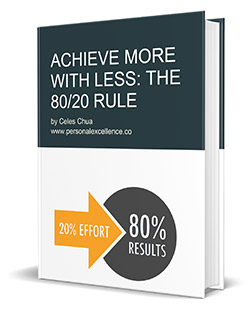
This is part 2 of a 3-part series on the 80/20 principle and how to achieve more with less in life with it.
- Part 1: The 80/20 Principle: How To Achieve More With Less In Life
- Part 2: Why You Should Not Resist The 80/20 Principle
- Part 3: Apply 80/20 to Your Life Now in 3 Simple Steps

(Image: Personal Excellence)
When teaching the 80/20 principle in my classes, I notice some common misconceptions about it. Here I want to clarify them:
- Misconception #1: 80/20 means eliminating all unimportant tasks. Not true. Some tasks are low impact but need to be done. For example, washing laundry and paying the bills. Not doing them will create significant negative downsides. The 80/20 principle is about spending more time on the important, spending less time on the unimportant (by automating, batching, delegating, etc.), and eliminating the tasks with almost no value (not doing them will not make a difference).
- Misconception #2: It must be precisely 80/20. Not necessarily. As I mentioned in Part 1, It just happened that Pareto’s observation was 80-20 (rather than 70-20). So say you have 10 tasks on your to-do list. It doesn’t mean that there must be precisely 2 tasks (20% of the 10 tasks) of high impact. Maybe you have 3 tasks that contribute to 80% of the results. Maybe 4 of the tasks contribute to 90% of the results. The point is that a small percentage of inputs leads to a large percentage of results.
- Misconception #3: The numbers should add up to 100. 80% represents the effects while 20% represents the causes. When Pareto made the connection, it was regarding the distribution of wealth in Italy, where 20% of people owned 80% of the land. The reality is that it can be 70/20, 90/30, etc. The percentage of causes and the percentage of effects do not have to add up to 100.
- Misconception #4: 80/20 is about being lazy. No — 80/20 is about being effective. When you use the 80/20, you think about the areas where you can make the most impact so that you can focus on them. It’s about using your limited energy to create the maximum impact, rather than being haphazard and unstrategic in the way you do things.
- Misconception #5: It only applies to business. While 80/20 gained popularity in the business world, it can be found in almost everything in life. It can be found in sports, science, software, medicine, and more. It can be found in our relationships, beliefs, goals, habits (20% of habits will make the biggest difference), and health (20% of actions will make the biggest difference to our health). It’s really a way of life.
- Misconception #6: 80/20 is about being mercenary. Some people resist the 80/20 because they don’t want to choose. They are uncomfortable saying no. They want to do everything. But when you don’t apply the 80/20, you are already choosing — you are choosing against the high-impact tasks that can benefit enormously from your attention and focus. 80/20 is about choosing to make the most impact with your limited time on Earth.
My initial resistance toward 80/20
I used to write off the 80/20 principle because I felt it was at odds with my perfectionist self. My belief was that we should give our 100% in everything, rather than pick things to focus on. I also felt that the end result of any activity came from the sum of its inputs. If we were to cut away the parts that “do not matter as much,” the net result would suffer in ways we could not anticipate.
But these feelings came from linear thinking and not looking at the big picture. I later realized that I was looking at things in the wrong way, without regard for resource constraints. Sure, in a perfect world where I had unlimited time, energy, and resources (money, etc.) at my disposal, then the 80/20 wouldn’t matter. If I could split myself into 100 bodies and be in 100 places at once, plus not sleep without detriment to my body, then I could focus on 100% of inputs with 100% dedication.
But because human energy is finite, and we have a non-renewable resource that is our time on Earth, we need to be conscious of how we spend our time and energy. That’s where the 80/20 principle comes in. Over the years, by applying the 80/20, I’ve learned to
- Focus on the goals that make the most difference, rather than overwhelming myself with 20 little goals.
- Identify the few key tasks that grow my blog the fastest, and hence grew my blog quickly to be one of the top self-help blogs today.
- Focus on positive relationships that uplift me, rather than drain myself with negative people and people who simply don’t appreciate my help.
- Not strive to serve every customer (or reader), but to serve customers who appreciate what I do, who value my time, and who don’t take me for granted. Knowing that I can remove the 0.01% toxic web visitors has freed up much of my mental energy to serve the 99.99%.
For the idealist and perfectionist, the 80/20 principle is even more important because it helps us achieve more and be more despite our limited time and energy. By prioritizing correctly and putting our energy in the right places, we get much more out of life.
The Role of Judgment in 80/20
Like any law or principle, the application by people means that perception and judgment will come into play.
This means that we may make mistakes. We may think that certain tasks are 20% high-impact tasks when they aren’t. We may cut off certain low-impact tasks that turn out to be crucial later.
The best way to tackle this is to improve our judgment. This can be done by learning. By making mistakes. By measuring our results and quantifying the link between input and output. By studying what the best people are doing, we can learn from them.
Remember that when you do not make a choice on what to do, you make a choice against other things that can grow significantly under your care. Rather than avoid making choices because you are afraid to cut out something important, strive to refine your judgment to make better decisions. Since there will always be a certain degree of error in our judgment, we can only strive for the most accurate application of the 80/20 rather than perfection. We may never be 100% correct, but the more we learn, the more data points we have to improve our judgment and make a more accurate assessment.
As we see more positive results, it means we are moving in the right direction. With practice, we can only get better. :)
In the last part, I share a 3-step method to apply 80/20 to all areas of your life. Read Part 3: Apply 80/20 to Your Life in 3 Simple Steps
This is part 2 of a 3-part series on the 80/20 principle and how to achieve more with less in life with it.








 I hope you find my content helpful. Join my community of 65,000 readers and get my latest articles delivered to your inbox. Your email is safe and I never send spam.
I hope you find my content helpful. Join my community of 65,000 readers and get my latest articles delivered to your inbox. Your email is safe and I never send spam.
Hi Celes,
Good post! I used to struggle with the 80/20 rule when it came to dealing with people. I thought it was just so unfair to pay more attention to some people when we are all created equal etc.
You’re right that the principle urges us to invest our energy more wisely, rather than take it to extremes or letting it affect our attitude.
I like the way you organise your posts into parts of a series. I used to do that but stopped, and you’ve reminded me of how sensible it is to do that – post a few topics on the same theme. You’re doing great!
Commenting for this post is closed.